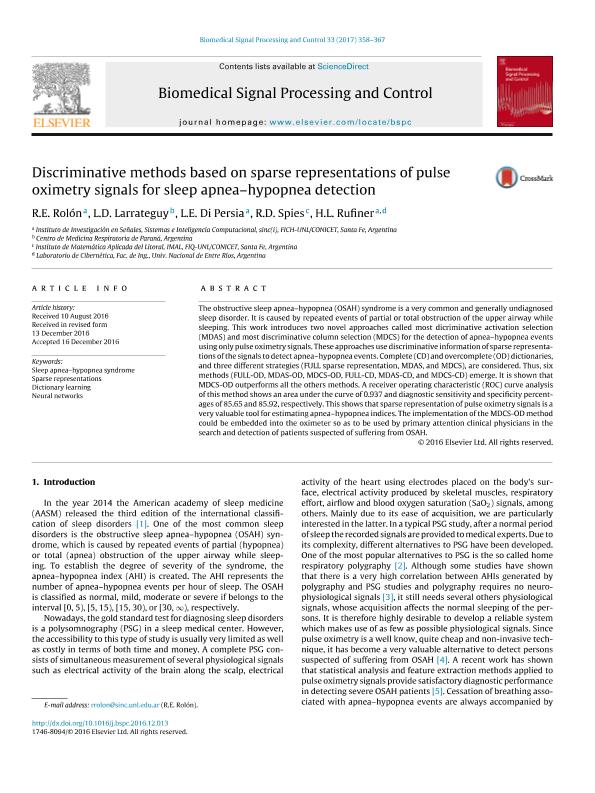Artículo
Discriminative methods based on sparse representations of pulse oximetry signals for sleep apnea–hypopnea detection
Rolon, Roman Emanuel ; Larrateguy, Luis Darío; Di Persia, Leandro Ezequiel
; Larrateguy, Luis Darío; Di Persia, Leandro Ezequiel ; Spies, Ruben Daniel
; Spies, Ruben Daniel ; Rufiner, Hugo Leonardo
; Rufiner, Hugo Leonardo
 ; Larrateguy, Luis Darío; Di Persia, Leandro Ezequiel
; Larrateguy, Luis Darío; Di Persia, Leandro Ezequiel ; Spies, Ruben Daniel
; Spies, Ruben Daniel ; Rufiner, Hugo Leonardo
; Rufiner, Hugo Leonardo
Fecha de publicación:
03/2017
Editorial:
Elsevier
Revista:
Biomedical Signal Processing and Control
ISSN:
1746-8094
Idioma:
Inglés
Tipo de recurso:
Artículo publicado
Clasificación temática:
Resumen
The obstructive sleep apnea?hypopnea (OSAH) syndrome is a very common and generally undiagnosed sleep disorder. It is caused by repeated events of partial or total obstruction of the upper airway while sleeping. This work introduces two novel approaches called most dicriminative activation selection (MDAS) and most discriminative column selection (MDCS) for the detection of apnea?hypopnea events using only pulse oximetry signals. These approaches use discriminative information of sparse representations of the signals to detect apnea?hypopnea events. Complete (CD) and overcomplete (OD) dictionaries, and three different strategies (FULL sparse representation, MDAS, and MDCS), are considered. Thus, six methods (FULL-OD, MDAS-OD, MDCS-OD, FULL-CD, MDAS-CD, and MDCS-CD) emerge. It is shown that MDCS-OD outperforms all the others methods. A receiver operating characteristic (ROC) curve analysis of this method shows an area under the curve of 0.937 and diagnostic sensitivity and specificity percentages of 85.65 and 85.92, respectively. This shows that sparse representation of pulse oximetry signals is a very valuable tool for estimating apnea?hypopnea indices. The implementation of the MDCS-OD method could be embedded into the oximeter so as to be used by primary attention clinical physicians in the search and detection of patients suspected of suffering from OSAH.
Archivos asociados
Licencia
Identificadores
Colecciones
Articulos(IMAL)
Articulos de INST.DE MATEMATICA APLICADA "LITORAL"
Articulos de INST.DE MATEMATICA APLICADA "LITORAL"
Articulos(SINC(I))
Articulos de INST. DE INVESTIGACION EN SEÑALES, SISTEMAS E INTELIGENCIA COMPUTACIONAL
Articulos de INST. DE INVESTIGACION EN SEÑALES, SISTEMAS E INTELIGENCIA COMPUTACIONAL
Citación
Rolon, Roman Emanuel; Larrateguy, Luis Darío; Di Persia, Leandro Ezequiel; Spies, Ruben Daniel; Rufiner, Hugo Leonardo; Discriminative methods based on sparse representations of pulse oximetry signals for sleep apnea–hypopnea detection; Elsevier; Biomedical Signal Processing and Control; 33; 3-2017; 358-367
Compartir
Altmétricas



